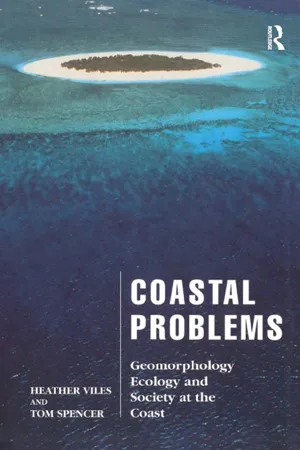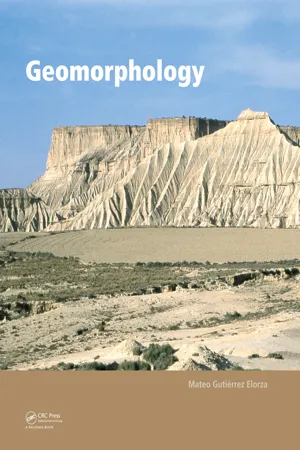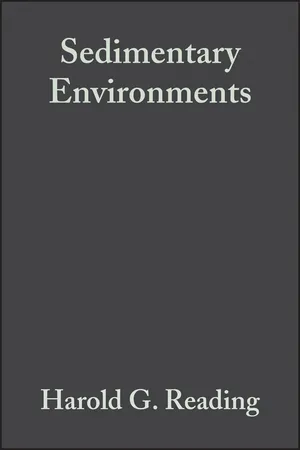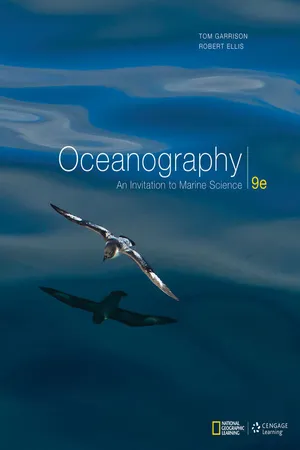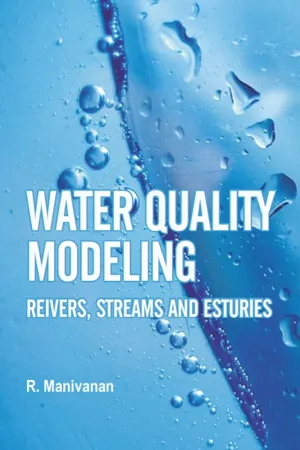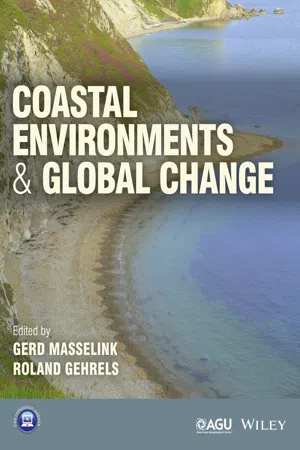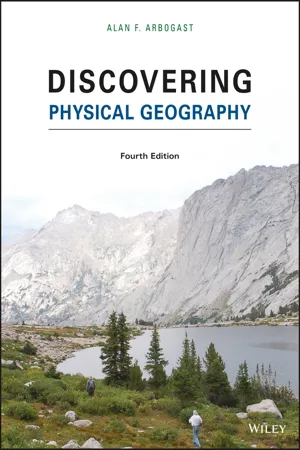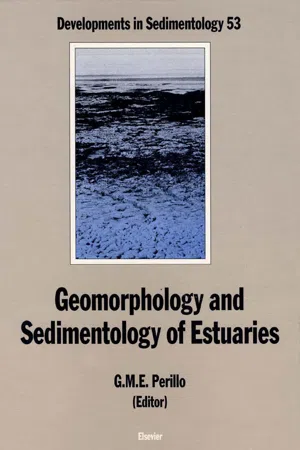Geography
Classification of Coasts
The classification of coasts is based on their formation and features. Coasts can be categorized as primary or secondary, based on their origin. Primary coasts are formed by geological processes, while secondary coasts are shaped by factors such as erosion and deposition. Additionally, coasts can be classified as emergent or submergent, depending on whether they are rising or sinking relative to sea level.
Written by Perlego with AI-assistance
Related key terms
1 of 5
11 Key excerpts on "Classification of Coasts"
- eBook - ePub
- Simon K. Haslett(Author)
- 2016(Publication Date)
- University of Wales Press(Publisher)
Coasts operate as open systems, with the flow of energy and material into, through and out of the coastal system. Coastal morphology aims to attain a state of equilibrium with the reigning processes; however, change within the system may trigger feedbacks, which may either accentuate the change (positive feedback) or help to minimise its effect (negative feedback).The Classification of Coasts is problematic, but on the broad scale the use of tectonic conditions helps us subdivide the global coastline into leading edge, trailing edge and marginal sea coasts, each possessing a range of characteristic attributes.- The use of diverse and sometimes confusing terminology in studying coasts is important for the student to command.
DISCUSSION QUESTIONS- Examine the problems in constructing a meaningful definition of the coast.
- The study of coasts is well suited to a systems approach. Discuss why this might be so.
- Assess the significance of tectonics in the development of a global coastal classification scheme.
FURTHER READINGSEE ALSOAdministrative coastal management issues, section 6.2.4 The development of shore platforms, section 2.3.2 Wave Classification of Coasts, section 2.1 Tidal classifications of coasts, sections 3.2 and 3.3 Wave and beach terminology, sections 2.2 and 2.6.1INTRODUCTORY READINGAn Introduction to Physical Geography and the Environment (3rd edn). J. Holden (editor). 2012. Pearson, Harlow, 904pp. Chapter 15 Coasts provides a useful introductory overview.Fundamentals of Geomorphology (3rd edn). R. J. Huggett. 2011. Routledge, London, 536pp. Part II deals with the general influence of geological structure on landscape development, whilst Chapter 13 specifically examines coastal landscapes.Fundamentals of the Physical Environment (4th edn). P. Smithson, K. Addison and K. Atkinson. 2008. Routledge, London, 792pp. Chapters 1, 2 and 17 are all useful in expanding further the themes introduced in this chapter.Introducing Physical Geography (4th edn). A. H. Strahler and A. Strahler. 2005. Wiley, New York, 752pp. Chapter 17 Landforms and Rock Structure - eBook - ePub
Coastal Problems
Geomorphology, Ecology and Society at the Coast
- Heather Viles, Tom Spencer(Authors)
- 2014(Publication Date)
- Routledge(Publisher)
Chapter Two HOW COASTS WORK IntroductionFrom the dramatic, precipitous cliffs of the Banks Peninsula, South Island, New Zealand to the palm-fringed, gleaming white, coral sands of a Seychelles beach there is an almost infinite variety of coastal scenery. In any one place the coastal zone consists of the same basic components (water, air, sediments, rocks and organisms), but how they are structured depends on a range of factors including geology, climate and oceanographic regime. Contemporary processes interact with landforms produced by past changes in sea level, sediment supply and process regime. Many North American and north-west European coasts, for example, show strong legacies, in terms of sea level change and recent sediment supply, from the repeated advance and retreat of large ice sheets over the last 1–2 million years.Many attempts have been made to classify and explain the diversity of coastal environments using genetic or descriptive criteria, or a mixture of the two. Thus Johnson (1919) split coasts into submergent, emergent, neutral and compound, depending on their recent history of relative sea level, Shepard (1963) divided coasts according to the relative importance of coastal and non-coastal processes, recognizing primary coasts (virtually unmodified by coastal processes) and secondary forms, and Davies (1964, 1972) split the world’s coastline up according to wave activity leading to a division into high latitude storm wave coasts, low latitude swell wave coasts and low energy coasts. Clearly all these different approaches are of value. Here we recognize the importance of variations in geological structure, sea level history and biogeography in providing contexts within which both contemporary ecological and geomorphological processes act and future environmental changes will be placed.Plate tectonics and coastal typeInman and Nordstrom (1971) produced an important classification based primarily on plate tectonics. They define three major coastal scales as shown in Table 2.1 . The controls operative at the first and second order provide a classification (tectonic and morphological) for the whole coastal zone. The controls operating at the third order help classify features within the shore zone. Coastal type at the large scale, therefore, is determined by the position of the area relative to plate margins, leading to a division of the world’s coastline into collision, trailing-edge and marginal sea coasts (Fig. 2.1 ). Collision, or active margin, coasts are typically characterized by the delivery of relatively coarse sediments from mountainous catchments to a coastal zone characterized by a narrow continental shelf and deep water not far offshore. Trailing edge, or passive margin, coasts by comparison are fed by large rivers often draining enormous drainage basins, thus contributing large volumes of fine sediments to wide, low-angle continental shelves. Most of the world’s major deltas are associated with trailing-edge coasts and they are also characterized by extensive barrier island development. Collision coasts, as in the Mediterranean and south-east Asia, often support only rocky shorelines, with poor beach or reef development, and exhibit sea level histories complicated by regional tectonic movements. These controls help provide a basis for the second order of Inman and Nordstrom’s (1971) classification (Table 2.2 - eBook - PDF
- Tom Garrison, Robert Ellis(Authors)
- 2017(Publication Date)
- Cengage Learning EMEA(Publisher)
Copyright 2018 Cengage Learning. All Rights Reserved. May not be copied, scanned, or duplicated, in whole or in part. WCN 02-300 153 8 Coasts KEY CONCEPTS The location of a coast depends on global tectonic activity and the ocean’s water volume. The shape of a coast is a product of uplift and subsid-ence, the wearing down of land by erosion, and the redistribution of material by sediment transport and deposition. Coasts may be classified as erosional coasts (on which erosion dominates) or depositional coasts (on which deposition dominates). Beaches change shape and volume as a function of wave energy and the balance of sediment input and removal. Human interference with coastal processes has generally accelerated the erosion of coasts near inhabited areas. Coasts are places of rapid change, tenacious organisms and often great beauty. The northern California coastline along Big Sur is a stunning example of the complexity that can occur at the land and sea interface. Lynn Y/Shutterstock.com Post-Glacial Sea Level Rise 20 18 0 12 6 0 14 8 4 16 10 2 Thousands of years ago 00 50 50 25 75 75 Copyright 2018 Cengage Learning. All Rights Reserved. May not be copied, scanned, or duplicated, in whole or in part. WCN 02-300 CHAPTER 8 154 8.1 Coasts Are Shaped by Marine and Terrestrial Processes Coastal areas join land and sea. Our personal experience with the ocean usually begins at the coast. Have you ever wondered why a coast is shaped as you see it? These temporary, often beautiful junctions of land and sea are subject to rearrange-ment by waves and tides, by gradual changes in sea level, by biological processes, and by tectonic activity. The place where ocean meets land is usually called the shore , and the term coast refers to the larger zone affected by the processes that occur at this boundary. - eBook - PDF
- Mateo Gutierrez(Author)
- 2012(Publication Date)
- CRC Press(Publisher)
11 COASTAL GEOMORPHOLOGY 1. Introduction 2. Brief history of coastal geomorphology 3. Temporal and spatial scales 4. Sea level variations 5. Waves, currents, and tides 6. Cliff coasts and rocky platforms 7. Coral reef coasts 8. Beaches, barriers, and spits 9. Coastal dunes 10. Mudflats, salt marshes, and mangroves 11. Estuaries and deltas 12. Coastal environments: Uses, management, and risks 11.1 Introduction Bird (2000) defines coastal geomorphology as the study of the evolution of coastal landforms, the processes that affect them, and the changes they undergo. These landforms include cliffs, rocky coastal margins, beaches, dunes, estuaries, lagoons, and deltas. The world’s coastal margins are about 100 m wide and 440,000 km long; humans use them for industrial pur- poses, transportation, and recreation. These human activities profoundly impact these areas. The United Nations estimates that 66% of the world’s population lives within a few kilom- eters of the coast (Pethick, 1984). As a result, food produc- tion, communication, cities, and recreational areas all affect the coast. Coasts have significant problems that include flood- ing, erosion, pollution, and sea level variations that require constant attention. Interdisciplinary studies by coastal engi- neers, oceanographers, and geomorphologists have led to significant advances in coastal management (Stephenson and Brander, 2003). In addition, coasts are constantly changing; the change may be catastrophic or imperceptible. Modifica- tions may occur over decades or centuries but they can also take place in a period of hours or minutes. 11.2 Brief history of coastal geomorphology Prior to the 20th century, research on coastal geomorphology was limited to engineering topics related to coastal erosion (Walker and MacGraw, 2005). Charles Darwin made impor- tant observations on coral reefs and the origin of atolls during his famous voyage on the British ship, the Beagle, in 1835 (Shepard, 1959). - eBook - ePub
Sedimentary Environments
Processes, Facies and Stratigraphy
- Harold G. Reading(Author)
- 2013(Publication Date)
- Wiley-Blackwell(Publisher)
6
Clastic coasts
H.G. Reading & J.D. Collinson** Parts of this chapter are based on the second edition, written by T. Elliott.6.1 Introduction
The coast is a broad zone that reaches from the landward limit of marine processes to the seaward limit of alluvial and shoreline processes. It includes not only deltas, beaches, barrier islands, tidal flats, tidal inlets, estuaries and cheniers but all those parts of the coastal plain affected by the proximity of a shoreline (Summerfield, 1991, p. 313) (Fig. 6.1 ).The shoreline , on the other hand, is a line of demarcation between sea, lake, or lagoonal waters and an exposed beach (Komar, 1976, p. 13). It is therefore a local and transient feature.Shorelines are obvious geomorphological boundaries and are the first to be drawn on many palaeogeographic maps. In ancient successions, coastal zones are relatively easy to identify using fossils because not only may they contain a brackish-water fauna but they also coincide with vertical and/or lateral changes from strata with dominantly marine fauna to strata with freshwater or no fauna. Hence landward migrations of the shoreline (transgressions) and seaward migrations of the shoreline (regressions) are comparatively easy to pin-point in both space and time. Identification of shoreline deposits may be crucial in the documentation of sea-level changes and discussion in sequence stratigraphic analysis.Coasts may be either dominantly erosional or dominantly depositional. Erosional coasts may be backed by cliffs of consolidated rock, or by loose or semi-consolidated sediment. Depositional coasts may be either devoid of terrigenous sediment, allowing biochemical sediments to form (Chapters 8 & 9), or receive a substantial supply of terrigenous sediment, derived either directly from the land via a river system, or from an adjacent coast or shelf by marine processes. As alluvial sediment reaches the shore, it is redistributed by basinal processes such as longshore drift, coastal current drift, waves, storms and tidal currents. Thus siliciclastic coastlines reflect the interplay of two competing suites of processes, fluvial currents and basinal energy, and two distinct sources of sediment. Where the coastline is fed directly from a contemporary river that supplies sediment more rapidly than basinal energy can redistribute, a discrete shoreline protuberance develops that has been called a delta - eBook - PDF
Oceanography
An Invitation to Marine Science
- Tom Garrison(Author)
- 2015(Publication Date)
- Cengage Learning EMEA(Publisher)
The location of a coast depends primarily on global tectonic activity and the volume of water in the ocean. The shape of a coast is a product of many processes: uplift and subsidence, the wearing down of land by erosion , and the redistribution of material by sediment transport and deposition. As we saw in Chapter 3, no area of geology has been left undisturbed by the revelations of plate tectonics. In the 1960s, geologists began to classify coasts according to their tectonic po-sition. Active coasts, near the leading edge of moving continental plates, were found to be fundamentally different from the more passive coasts near trailing edges. The shapes, compositions, and ages of coasts are better understood by taking plate movements into account. But as we’ll see, the slow forces of plate movement Tom Garrison Media Connection Start off this chapter by listening to a podcast with David Braun as he re-ports on how the global water cycle is causing sea level rise, driving coasts inland. Visit www.cengagebrain.com to access MindTap, a complete digital course that includes this podcast and other resources. Copyright 2016 Cengage Learning. All Rights Reserved. May not be copied, scanned, or duplicated, in whole or in part. Due to electronic rights, some third party content may be suppressed from the eBook and/or eChapter(s). Editorial review has deemed that any suppressed content does not materially affect the overall learning experience. Cengage Learning reserves the right to remove additional content at any time if subsequent rights restrictions require it. COASTS 337 are frequently obscured by the more rapid action of waves, by the erosion of land, and by the transport of sediments. Another important consideration in understanding coasts is long-term change in sea level. - eBook - PDF
Water Quality Modeling
Rivers, Streams and Estuaries
- R. Manivanan(Author)
- 2021(Publication Date)
- 93 - 7.1 Introduction The coast is one of the most important boundaries in the world. It separates the marine part of the world from the continents. It separates the salt-water communities from fresh water communities; it separates land life from water borne life but amphibians living both environments (Fig. 7.1). Some of the marine organisms move towards estuary for reproduction with less water salinity. The coastline as such is not a stable. It fluctuates in place over considerable distances due to erosion and sedimentation, but also due to the relative change of sea level with respect to land. The coastal zone is thus a very mobile part of the earth from a geographical point of view. Due to its specific geophysical properties, the coast is also a very important area for the development of flora and fauna. There is hardly any other part of the world that houses such a variety of species, both in flora and fauna. The abundance of opportunities along the coast has also attracted a lot of human activities. The coastal zone has become an indispensable resource for mankind. It provides excellent opportunities for fisheries, housing, recreation, transport, defense purpose, industrial activities and many others. The influx of man with their social and economic Chapter 7 Modeling: Coastal and Estuaries 94 WATER QUALITY MODELING activities, their needs for safe housing, food, drinking water, and with the tremendous quantities of waste they are producing poses at the same time a serious threat to the unique features of the coastal zone. It is therefore necessary to study this valuable region so as to prevent that competing activities are gradually causing depletion of the resources in the coastline. The following figures (Fig. 7.1and 7.2) show the typical coastal area of rocky coast and sandy coast. - eBook - PDF
- Gerd Masselink, Roland Gehrels, Gerd Masselink, Roland Gehrels(Authors)
- 2014(Publication Date)
- American Geophysical Union(Publisher)
Rock Coasts 357 origin of rock coasts and the lack of a dynamic response (e.g. accretion) to sea-level rise that other systems such as reefs, beaches and salt marshes are capable of exhibiting. Rock coasts have no capacity to recover from storm events in the way beaches can rebuild as sediment is transported onshore. Rock coast morphology can be broadly categorized into three types (Fig. 15.1): (1) sloping shore platforms backed by a cliff (Type A shore platform); (2) near-horizontal plat- form with a landward cliff and characterized by a seaward drop, sometimes referred to as a low-tide cliff as the upper part of the cliff is seen at low tide (Type B shore platform); and (3) plunging cliffs where no platform is present. Water depths in front of a plunging cliff are deep enough that waves do not break against the cliff face, but reflect off it. Despite this simple tripartite classification, rock coast morphology is far more complex than Fig. 15.1 sug- gests, as highlighted in Fig. 15.2. For example, many cliffs are fronted by beaches. Whether or not shore platforms are backed by an active cliff has much to do with recent changes in sea level and/or tectonic processes. Numerous shore platforms can be found that are backed by beaches resting in front of inactive and abandoned cliffs. 15.2 Geology and lithology Rock coasts and associated landforms develop in a bewil- dering array of geological and lithological settings, from hard and highly resistant granite to relatively weak con- solidated gravels and loess, and with variations in the den- sity of bedding and joints (Fig. 15.3). The overall similarity of coastal rock landforms (cliffs and platforms) belies that complexity, and is often expressed in differing rates of development and a variety of resulting morphologies. Geology and lithology have a significant bearing on the efficiency of erosional processes and consequently are a primary control on the morphology of rock coasts. - eBook - PDF
- Alan F. Arbogast(Author)
- 2017(Publication Date)
- Wiley(Publisher)
If the top of the arch collapses, an isolated sea stack remains, such as the one to the left. Note the tilted rock strata. 450 CHAPTER 19 Coastal Processes and Landforms Depositional Coastlines We have just seen how coastlines are shaped by erosion and some of the diagnostic landforms that result from this process. Now, let’s turn to the coastal landforms created when sediment is deposited in various ways and places. You were briefly intro- duced to this concept with the formation of a pocket beach be- tween two eroding headlands (Figure 19.14c). Coastlines in the process of extending outward into the water through deposi- tion are said to be undergoing progradation. Beaches The part of the coastal landscape people are probably most familiar with is the beach. Beaches are dynamic places where sediment is deposited through the combination of waves, beach drift, and wind. In some places, beaches are supplied with alluvial sands derived from land far inland. The beach is a transition between the water and the landmass and consists of exposed, unconsolidated sediments that usually range from sand to cobbles. Although finer silt and clay-sized particles are sometimes contained within a beach, they are usually carried away in suspension by the longshore current. Most beach growth occurs during the summer months in the Northern Hemisphere when the weather is relatively calm. In winter, however, beaches can be significantly eroded due to large waves created by strong storms. If you happen to live on or near a beach, notice how the shape of the beach can change between seasons. Figure 19.21 shows how beach components are differenti- ated on the basis of their relative position to the water. The offshore is permanently submerged and is the zone where waves break and the surf is most active. - eBook - PDF
Physical Geology
The Science of Earth
- Charles Fletcher(Author)
- 2017(Publication Date)
- Wiley(Publisher)
Rivers tend to cut Coasts May Be Submergent or Emergent, Depositional or Erosional, or Exhibit Aspects of All Four of These Characteristics 639 into steep mountainous watersheds with high gradients. Sediments on these coasts are coarse grained, and wet- lands and estuaries on them tend to be narrow and poorly developed. All these features are common to shorelines that generally act as sediment sources rather than as sites of sed- iment accumulation. Depositional coasts, in contrast, often are associated with old mountain systems that are no longer tectonically active. With long periods of geologic time during which to shed sediments into the coastal zone, a broad continental shelf to diffuse wave energy, and wide coastal plains to collect and store sediments, these coastal systems are characterized by abundant sediment that forms barrier island chains, deltas, broad lagoons, and extensive tidal wetlands. River valleys in them tend to be wide and flat. In general, depositional coasts are found in midplate settings where little active mountain building takes place (Figure 20.33). Test your understanding of these complex environments by completing the following Critical Thinking exercise. FIGURE 20.33 (a) Erosional coasts are characterized by eroding sea cliffs, sea stacks, and short beaches in narrow embayments. (b) Depositional coasts collect large quantities of sediment. Coastal wetlands tend to be found on depositional coasts. robertharding/Alamy Stock Photo (a) How is the tectonic setting likely to differ between erosional and depositional coasts? Concept Check 20.10 Please complete this exercise before coming to class. Identify the best answer to each question. 29. In time, the shoreline in this photo will: a. Develop deeper embayments. b. Grow larger headlands due to beach erosion. c. Not change significantly. d. Tend to straighten. e. None of the above. 30. Shorelines on tectonically stable lands that collect sediment are termed: a. - eBook - PDF
- Gerardo M.E. Perillo(Author)
- 1995(Publication Date)
- Elsevier Science(Publisher)
Sediments, for instance, are common enough to all of them; nevertheless, their variation within a single estuary may be so large and dynamical and geomorphologically dependent that 28 G.M.E. PERILLO a classification based only on sediment distribution patterns seems impracticable. The same occurs with tidal current intensity or winds. In the present section a review of several of the most common classifications is presented. The objective of the descriptions that follow is two fold: to introduce the classificationperse, but further on is to introduce the readers with the basic terminol- ogy and the particular environment that will be tackled in the following chapters. As a result, the particular description given for each element of any classificationis com- posed from what the author originally indicated plus general interpretations added from other authors and myself. Each subtitle will be accompanied by the name of the researcher(s) that developed the classification.Afterward, a new morphogenetic classification is introduced. Physiographic classification (Pritchard, 1960) The first known classification of estuaries from a geomorphologic point of view is due to Pritchard (1952) who divided the estuaries in three groups: drowned rivers, fjords and bar-built estuaries. Later, Pritchard (1960) completed the classification by including a fourth category that contemplated those formed by tectonic processes. Some features of the estuaries included in this classification will be discussed at length since they will be employed also in the following classifications. Drowned river valleys This term has been wrongly employed in many occasions as synonymous of coastal-plain estuaries. They are basically what everybody thinks an estuary should be. They were formed by sea flooding of Pleistocene-Holocene river valleys during the Flandrian transgression. In Fig. 2-6 a schematic view of a classical drowned river estuary is exhibited.
Index pages curate the most relevant extracts from our library of academic textbooks. They’ve been created using an in-house natural language model (NLM), each adding context and meaning to key research topics.

